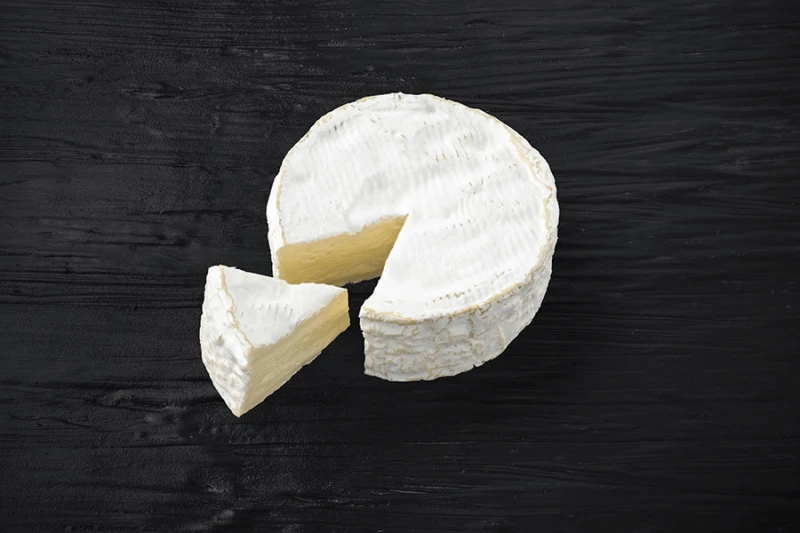Genetic diversity squeeze: Camembert is on the verge of extinction. Here’s what can be done to rescue ‘endangered cheeses’
Genetic diversity squeeze: Camembert is on the verge of extinction. Here’s what can be done to rescue ‘endangered cheeses’


Each hunk of Camembert or smear of brie is an ecosystem, an assortment of fungi and bacteria that turn milk fats and proteins into hundreds of different compounds. Those compounds produce the flavors, smells, and textures we love.
In recent decades, however, the genetic diversity of some of those microbes has caved. And today, some of the most famous French cheeses rely on just a single fragile strain of fungi that is at risk of dying out.
For reasons that are not totally clear, the [fungus strain Penicillium camemberti used in camembert and brie] can’t reproduce sexually, like most molds can — meaning, it can’t “breed” with another individual to create new genetic diversity. So to create more of this fungi, cheesemakers have to clone it, not unlike how you propagate a plant using a cutting. Yet decades of replicating the same individual can introduce harmful errors into its genome, [Centre national de la recherche scientifique (CNRS) evolutionary biologist Jeanne] Ropars said.
…
There is a way to save these cheeses, though it requires some changes in our own taste and tolerance.
To make Camembert or brie, cheese producers could simply inoculate cow’s milk with other Penicillium biforme molds, which are naturally present in raw milk (these microbes would need to be manually added if the milk is pasteurized). As a group, Penicillium biforme has a lot of genetic diversity and these molds are able to produce sexually, Ropars said, which is key to maintaining genetic diversity.
This is an excerpt. Read the original post here

 | Videos | More... |

Video: Nuclear energy will destroy us? Global warming is an existential threat? Chemicals are massacring bees? Donate to the Green Industrial Complex!
 | Bees & Pollinators | More... |

GLP podcast: Science journalism is a mess. Here’s how to fix it

Mosquito massacre: Can we safely tackle malaria with a CRISPR gene drive?

Are we facing an ‘Insect Apocalypse’ caused by ‘intensive, industrial’ farming and agricultural chemicals? The media say yes; Science says ‘no’
 | Infographics | More... |

Infographic: Global regulatory and health research agencies on whether glyphosate causes cancer
 | GMO FAQs | More... |

Why is there controversy over GMO foods but not GMO drugs?

How are GMOs labeled around the world?

How does genetic engineering differ from conventional breeding?
 | GLP Profiles | More... |

Alex Jones: Right-wing conspiracy theorist stokes fear of GMOs, pesticides to sell ‘health supplements’




 Viewpoint — Fact checking MAHA mythmakers: How wellness influencers and RFK, Jr. undermine American science and health
Viewpoint — Fact checking MAHA mythmakers: How wellness influencers and RFK, Jr. undermine American science and health Viewpoint: Video — Big Solar is gobbling up productive agricultural land and hurting farmers yet providing little energy or sustainabilty gains
Viewpoint: Video — Big Solar is gobbling up productive agricultural land and hurting farmers yet providing little energy or sustainabilty gains Fighting deforestation with CO2: Biotechnology breakthrough creates sustainable palm oil alternative for cosmetics
Fighting deforestation with CO2: Biotechnology breakthrough creates sustainable palm oil alternative for cosmetics Trust issues: What happens when therapists use ChatGPT?
Trust issues: What happens when therapists use ChatGPT? 30-year-old tomato line shows genetic resistance to devastating virus
30-year-old tomato line shows genetic resistance to devastating virus California, Washington, Oregon forge immunization alliance to safeguard vaccine access against federal undermining
California, Washington, Oregon forge immunization alliance to safeguard vaccine access against federal undermining The free-range chicken dilemma: Better for birds, but with substantial costs
The free-range chicken dilemma: Better for birds, but with substantial costs ‘You have to treat the brain first’: Rethinking chronic pain with Sanjay Gupta
‘You have to treat the brain first’: Rethinking chronic pain with Sanjay Gupta
